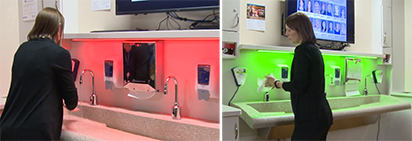When hearing the word “NICU,” the first image that appears in your mind is cute babies in incubators wearing tiny hats. If your family or friends experience the birth of a preemie, then the reality of a baby who needs specialized medical care really hits home. As an architect and a medical planner, the connection to a Neonatal Intensive Care Unit (NICU) patient and family changed the entire design project approach for me. These words from a new mom in the NICU will always resonate with me — “a child, the size of your hand, with a heart the size of a grape, and a hole in their heart the size of a pea.”
While many details of architecture are only seen as lines and text, the true caring within our work is helping the frailest patients. I was fortunate to be part of the Zimmerman team that designed an impactful project for the Children’s Wisconsin – Milwaukee NICU. This NICU is the largest in Wisconsin and cares for over 700 babies each year. To achieve the project’s highest goal — creating an environment that supports the growth and safe development of these tiny patients — our team incorporated several innovative design features.
Proper Hand Washing
Infection control is paramount in the NICU, where the patients are still developing immune systems and are vulnerable to infections. At the entry of the renovated NICU, care providers and visitors alike are required to wash their hands. To ensure that everyone washes for the proper amount of time, the design team incorporated color-changing lights at the hands-free sinks. While the light color slowly rotates through the color spectrum, you wash your hands until the starting color returns. The colorful cycle of the lights helps to ensure that families and visitors wash thoroughly for the appropriate length of time.

Controlled Lighting
Controlling light levels and providing highly adjustable lighting is critical in NICU design. Designing a lighting system that can cycle and provide levels of light appropriate for day and night is beneficial for infants as well as care providers and families. In the article, Reducing Noise in the Neonatal Intensive Care Unit, the authors state, “Several research studies have shown that compared to infants who remained in constant light or constant darkness, infants exposed to cycled light (bright during the day and dim at night) spent more time sleeping while in the NICU, and after discharge, had a greater rate of weight gain while in the NICU, were able to be fed orally sooner, spent fewer days on the ventilator, and displayed enhanced motor coordination.”
In this NICU, the design team used digitally controlled lighting to provide the ability to have “lighting scenes,” developed from many patient care considerations. Patients can require immediate care so medical staff has lighting controls placed in close proximity to the baby’s bed. No matter the time of day, care providers can press a single button to have an “all-on” emergency lighting. A benefit of digital controls is that changes in switching and light levels over time are possible without needing invasive wiring modifications or disrupting patient care.
Multiple lighting control points are available around the patient room, but when a switch has a unique need it was given a single location. In the NICU patient rooms, families have a zone of space designated as their comfort area. The light controls in this area support different light levels for reading, working and nighttime. Amber-colored night lights are located below the height of the baby’s bed so they will not interrupt sleep but allow parents to see details at night. The lighting controls are one of the ways families can customize the patient room environment.
Proximity to Daylight
The NICU expansion project was a challenging renovation within an existing facility. To maximize the available space, some patient rooms are located on the interior of the unit, without exterior windows. This clinically approved location has a benefit for the smallest patients who are sensitive to daylight. Many studies have shown the positive effects of daylight on hospital patients and visitors, but daylight can have a negative effect on NICU patients. Direct sunlight can reduce visibility in the NICU and may even harm the developing retina of the infant. When the babies reach 34 weeks, they can be moved to windowed patient rooms to further develop their circadian rhythm and natural light responses. In the patient rooms with exterior windows, daylighting levels are controlled with window treatments. To ensure that families still have connections to daylight and views of the outside during their time in the NICU, the family kitchen and lounge have exterior windows.
Sound Level Controls
The infants’ tiny ears and high sensitivity to sound are other factors important to consider in NICU design. In the article Reducing Noise in the Neonatal Intensive Care Unit, the authors state, “While meaningful sound (such as parents’ voices) stimulates proper development, noise in excess of 45 decibels (dB) can have adverse effects on the growth and neurodevelopment of neonates.” To help staff and family remain aware of appropriate sound levels, the patient rooms have an innovative “Twinkle Light” feature. Small lights set flush on the patient headwall shift color from white to yellow to red as noise levels in the patient room increase. The lights also flash to alert the room occupants of high sound levels. The light color returns to calm white when the noise drops to acceptable quieter levels.

Staff and families alike appreciate the quiet environment of the renovated NICU. A hospital is not often thought of as a quiet space, but our design team supported the NICU staff in reducing alarm fatigue by having required patient alarms, calls and pages routed to department cell phones. A care call escalation path permitted the quieting design of necessary hospital systems.
The walls of the patient rooms are also acoustically insulated to reduce the noise coming in from the corridor and adjacent rooms. No utilities, pipes or ducts were permitted to make openings side to side in the rooms, only at a controlled point at the corridor/door side. The patient room doors also have sound seals around the edges to help reduce the transmission of sound. These features combine to provide a quieter environment to promote the healthy development of infants.
The renovated and expanded 70 bed, Level IV NICU opened at Children’s Wisconsin – Milwaukee in 2017. This project has been one of the most rewarding of my career. I saw firsthand the impact that innovative design features have on patients and their families. While the focus of our work is healthcare design and architecture, we truly appreciate seeing the way nurses care and interact with families within this very special neighborhood for tiny patients.


